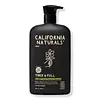What's inside
What's inside
 Key Ingredients
Key Ingredients

 Benefits
Benefits

 Concerns
Concerns

 Ingredients Side-by-side
Ingredients Side-by-side

Aloe Barbadensis Leaf Juice
Skin ConditioningCamellia Sinensis Leaf Extract
AntimicrobialSodium Coco-Sulfate
CleansingDecyl Glucoside
CleansingSodium Chloride
MaskingCoco-Glucoside
CleansingGlycerin
HumectantPanthenol
Skin ConditioningSimmondsia Chinensis Seed Oil
EmollientSymphytum Officinale Leaf Extract
Skin ConditioningUrtica Dioica Leaf Extract
Skin ConditioningMacrocystis Pyrifera Extract
Skin ConditioningLepidium Meyenii Root Extract
Skin ConditioningYucca Brevifolia Root Extract
Skin ConditioningSalix Alba Bark Extract
AstringentBenzyl Alcohol
PerfumingCitric Acid
BufferingDehydroacetic Acid
PreservativePotassium Sorbate
PreservativeAloe Barbadensis Leaf Juice, Camellia Sinensis Leaf Extract, Sodium Coco-Sulfate, Decyl Glucoside, Sodium Chloride, Coco-Glucoside, Glycerin, Panthenol, Simmondsia Chinensis Seed Oil, Symphytum Officinale Leaf Extract, Urtica Dioica Leaf Extract, Macrocystis Pyrifera Extract, Lepidium Meyenii Root Extract, Yucca Brevifolia Root Extract, Salix Alba Bark Extract, Benzyl Alcohol, Citric Acid, Dehydroacetic Acid, Potassium Sorbate
Water
Skin ConditioningCocamidopropyl Hydroxysultaine
CleansingSodium Methyl 2-Sulfolaurate
CleansingDisodium EDTA
Disodium 2-Sulfolaurate
CleansingAloe Barbadensis Leaf Juice
Skin ConditioningSodium Lauroyl Methyl Isethionate
CleansingGlycerin
HumectantButylene Glycol
HumectantDextran
Acetyl Tetrapeptide-3
Skin ProtectingTrifolium Pratense Flower
Skin ConditioningPersea Gratissima Oil
Skin ConditioningUrtica Dioica Extract
AstringentArgania Spinosa Kernel Oil
EmollientCucurbita Pepo Seed Oil
EmollientRicinus Communis Seed Oil
MaskingSerenoa Serrulata Fruit Extract
Skin ConditioningTocopherol
AntioxidantSaccharomyces/Xylinum/Black Tea Ferment
Skin ConditioningRosmarinus Officinalis Leaf Extract
AntimicrobialBiotin
AntiseborrhoeicPanthenol
Skin ConditioningNigella Sativa Seed Oil
EmollientLactobacillus Ferment
Skin ConditioningCitrus Aurantium Bergamia Peel Oil
Zinc Gluconate
Skin ConditioningAdenosine
Skin ConditioningCaffeine
Skin ConditioningCharcoal
AbrasiveEthylhexylglycerin
Skin ConditioningSodium Benzoate
MaskingPotassium Sorbate
PreservativeLactic Acid
BufferingIron Oxides
Galactoarabinan
Parfum
MaskingWater, Cocamidopropyl Hydroxysultaine, Sodium Methyl 2-Sulfolaurate, Disodium EDTA, Disodium 2-Sulfolaurate, Aloe Barbadensis Leaf Juice, Sodium Lauroyl Methyl Isethionate, Glycerin, Butylene Glycol, Dextran, Acetyl Tetrapeptide-3, Trifolium Pratense Flower, Persea Gratissima Oil, Urtica Dioica Extract, Argania Spinosa Kernel Oil, Cucurbita Pepo Seed Oil, Ricinus Communis Seed Oil, Serenoa Serrulata Fruit Extract, Tocopherol, Saccharomyces/Xylinum/Black Tea Ferment, Rosmarinus Officinalis Leaf Extract, Biotin, Panthenol, Nigella Sativa Seed Oil, Lactobacillus Ferment, Citrus Aurantium Bergamia Peel Oil, Zinc Gluconate, Adenosine, Caffeine, Charcoal, Ethylhexylglycerin, Sodium Benzoate, Potassium Sorbate, Lactic Acid, Iron Oxides, Galactoarabinan, Parfum
Ingredients Explained
These ingredients are found in both products.
Ingredients higher up in an ingredient list are typically present in a larger amount.
Aloe Barbadensis Leaf Juice comes from leaves of the aloe plant. Aloe Barbadensis Leaf Juice is best known for helping to soothe sunburns. It is also anti-inflammatory, moisturizing, antiseptic, and can help heal wounds.
Aloe is packed with good stuff including Vitamins A, C, and E. These vitamins are antioxidants, which help fight free-radicals and the damage they may cause. Free-radicals are molecules that may damage your skin cells, such as pollution.
Aloe Barbadensis Leaf Juice also contains sugars. These sugars come in the form of monosaccharides and polysaccharides, folic acid, and choline. These sugars are able to help bind moisture to skin.
It also contains minerals such as calcium, 12 anthraquinones, fatty acids, amino acids, and Vitamin B12.
Learn more about Aloe Barbadensis Leaf JuiceGlycerin is already naturally found in your skin. It helps moisturize and protect your skin.
A study from 2016 found glycerin to be more effective as a humectant than AHAs and hyaluronic acid.
As a humectant, it helps the skin stay hydrated by pulling moisture to your skin. The low molecular weight of glycerin allows it to pull moisture into the deeper layers of your skin.
Hydrated skin improves your skin barrier; Your skin barrier helps protect against irritants and bacteria.
Glycerin has also been found to have antimicrobial and antiviral properties. Due to these properties, glycerin is often used in wound and burn treatments.
In cosmetics, glycerin is usually derived from plants such as soybean or palm. However, it can also be sourced from animals, such as tallow or animal fat.
This ingredient is organic, colorless, odorless, and non-toxic.
Glycerin is the name for this ingredient in American English. British English uses Glycerol/Glycerine.
Learn more about GlycerinPanthenol is a common ingredient that helps hydrate and soothe the skin. It is found naturally in our skin and hair.
There are two forms of panthenol: D and L.
D-panthenol is also known as dexpanthenol. Most cosmetics use dexpanthenol or a mixture of D and L-panthenol.
Panthenol is famous due to its ability to go deeper into the skin's layers. Using this ingredient has numerous pros (and no cons):
Like hyaluronic acid, panthenol is a humectant. Humectants are able to bind and hold large amounts of water to keep skin hydrated.
This ingredient works well for wound healing. It works by increasing tissue in the wound and helps close open wounds.
Once oxidized, panthenol converts to pantothenic acid. Panthothenic acid is found in all living cells.
This ingredient is also referred to as pro-vitamin B5.
Learn more about PanthenolPotassium Sorbate is a preservative used to prevent yeast and mold in products. It is commonly found in both cosmetic and food products.
This ingredient comes from potassium salt derived from sorbic acid. Sorbic acid is a natural antibiotic and effective against fungus.
Both potassium sorbate and sorbic acid can be found in baked goods, cheeses, dried meats, dried fruit, ice cream, pickles, wine, yogurt, and more.
You'll often find this ingredient used with other preservatives.
Learn more about Potassium Sorbate